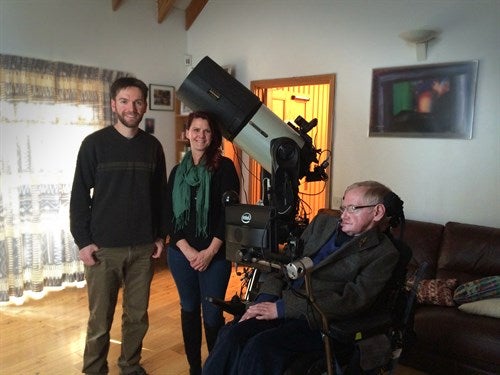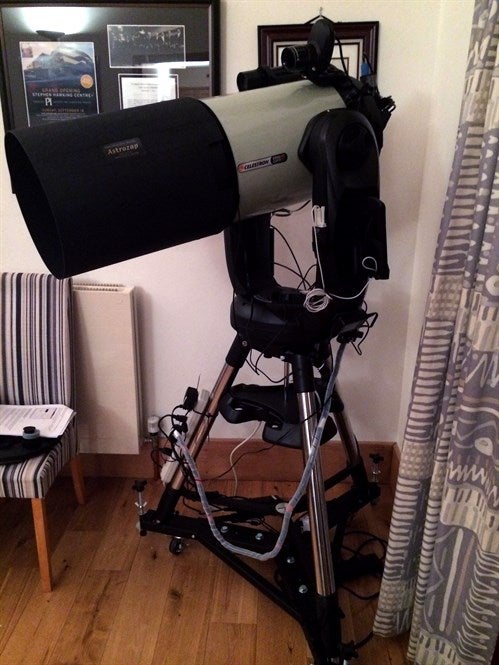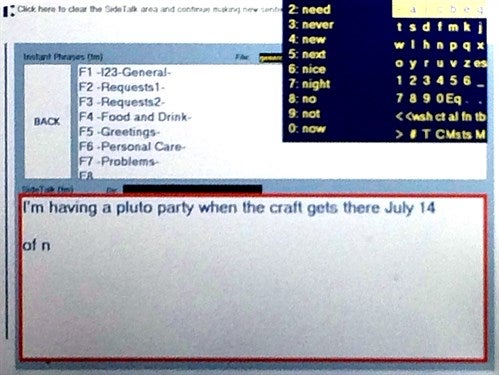It was a familiar scene for anyone who owns a telescope: a living room with boxes, plastic wrap, and Styrofoam strewn everywhere. Perched atop its tripod, a CPC Deluxe 1100HD telescope waited expectantly with wires, power cords, and USB cables dangling from every port.
Amidst the commotion, Stephen Hawking sat quietly in front of his computer, typing. The Andromeda Galaxy, the Pleiades star cluster—he was compiling a wish list of celestial objects to view with his new telescope.
The mood was excited and buzzing as Celestron employees and Hawking’s assistants worked together to assemble this one-of-a-kind telescope rig for one of the most brilliant scientific minds of all time.
A TELESCOPE DECADES IN THE MAKING
Although he’s spent his career pondering the nature of space-time and penning bestselling books on the origin of the universe, Stephen Hawking never had much experience with telescopes. At the age of 21, just as his career as a theoretical physicist was taking off, Hawking was diagnosed with ALS. A few years later, he would be confined to a wheelchair, unable to point a telescope at celestial objects or even view through an eyepiece.
Today, Hawking continues to research, write, and speak publicly thanks to a team of assistants and his Intel-based PC. At a recent scientific symposium in the Canary Islands, Hawking’s team approached Celestron to see if we had a telescope that was compatible with his computer. Thanks to recent advances in telescope technology, it’s now possible for Hawking to control a telescope remotely and view celestial objects in real time on his computer screen.
Hawking’s computer and another one connected to the telescope outside communicate via his home WiFi network. To slew to an object, Hawking types its name into a simplified interface using his cheek-controlled switch. Then, he can view the object or even capture photos.
Although it’s certainly elaborate, Hawking’s telescope rig doesn’t require any unique equipment; every component is available off-the-shelf through Celestron or third-party manufacturers. Interestingly, amateur astronomy and astroimaging have now become accessible, rewarding hobbies for those bound to a wheelchair.
The key was putting everything together in a way that Hawking and his “telescope-newbie” support staff could assemble and use without difficulty. StarSense AutoAlign—Celestron’s new accessory that allows the telescope to analyze star patterns overhead to calculate its own position—was a crucial part of that setup.
FIRST LIGHT IN CAMBRIDGE
By early evening, the telescope was built, the software was launched, and all systems were “go.” Next, we turned our eyes upward and waited. Another scene that’s all-too-familiar for new telescope owners: cloudy skies on the first night out.
Snow had fallen earlier that afternoon, but Hawking and the rest of our group held out hope that the weather would clear for a brief window of observing. After dinner, that moment finally came. The StarSense AutoAlign performed its task, aligning the telescope’s computer in a matter of minutes. But just as the message “Align Success” appeared on screen, the clouds rolled back in.
We turned our gaze to the one object bright enough not to be daunted by the clouds, our Moon. Normally the Moon would be too bright to photograph through the CCD camera we had attached at the time, designed for deep space astroimaging. But the clouds acted as a natural filter. Stephen Hawking’s first light image, a beautiful snapshot of the full Moon, appeared on his screen.
What was Professor Hawking’s response to the image? The note he asked his team to inscribe that night says it all: “You opened up the universe to me.”
After the initial wonder of first light, it was time to teach Hawking and his team how to use the telescope on their own. We returned to the Hawking home the next morning to begin training.
An avid student, Hawking demonstrated an insatiable curiosity to learn as much as possible about the telescope itself and the hobby of amateur astronomy. Throughout the day, he asked a steady stream of thoughtful questions.
What environment can the telescope be in?
What can you see on Mars?
Can one filter streetlight?
Can I view spectrum lines?
Hawking was quite the multitasker on the telescope’s second night out. As everyone ate dinner inside, he seized the moment and slewed his telescope to capture a pair of galaxies in Ursa Major, M81 and M82. With the help of his assistant, Hawking then slewed to and captured a favorite object among astroimagers, the Orion Nebula. Although he was brand new to imaging, Hawking’s work was impressive, showing vivid red color in the famous star-forming region in Orion.
After his marathon dinnertime imaging session, weather closed out and once again the Moon was the only visible target for the duration of the evening. Battling the clouds once more, he wrapped up that night with a close-up image of the Moon using our Skyris planetary imager, which showed multiple craters in detail.
A NEW JOURNEY AS AN AMATEUR ASTRONOMER
By the third day, Hawking and his team were setting up and controlling the telescope on their own. Although our time in Cambridge was coming to an end, Hawking’s new journey into deep space with his CPC Deluxe HD telescope was just beginning.
He told us of plans to host a “Pluto Party” in July to commemorate the arrival of the New Horizons spacecraft, the first man-made object to land on the surface of the dwarf planet.
As we headed home, we were humbled to have met a titan of the scientific world. It was an honor to share a glimpse into our universe with such an accomplished thinker. We are grateful to Professor Hawking, his graduate assistant Jonathan Wood, and the entire support staff in Cambridge for their kindness and hospitality throughout this one-in-a-lifetime experience. From our headquarters in Torrance, California, everyone at Celestron will be eagerly awaiting Stephen Hawking’s next astroimage.












